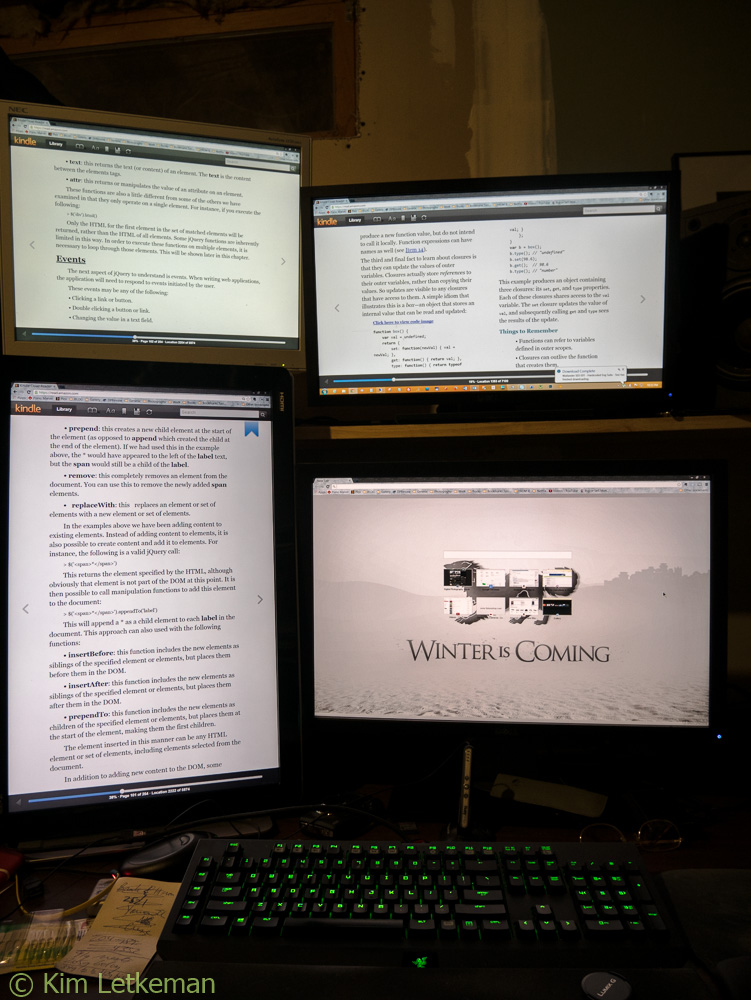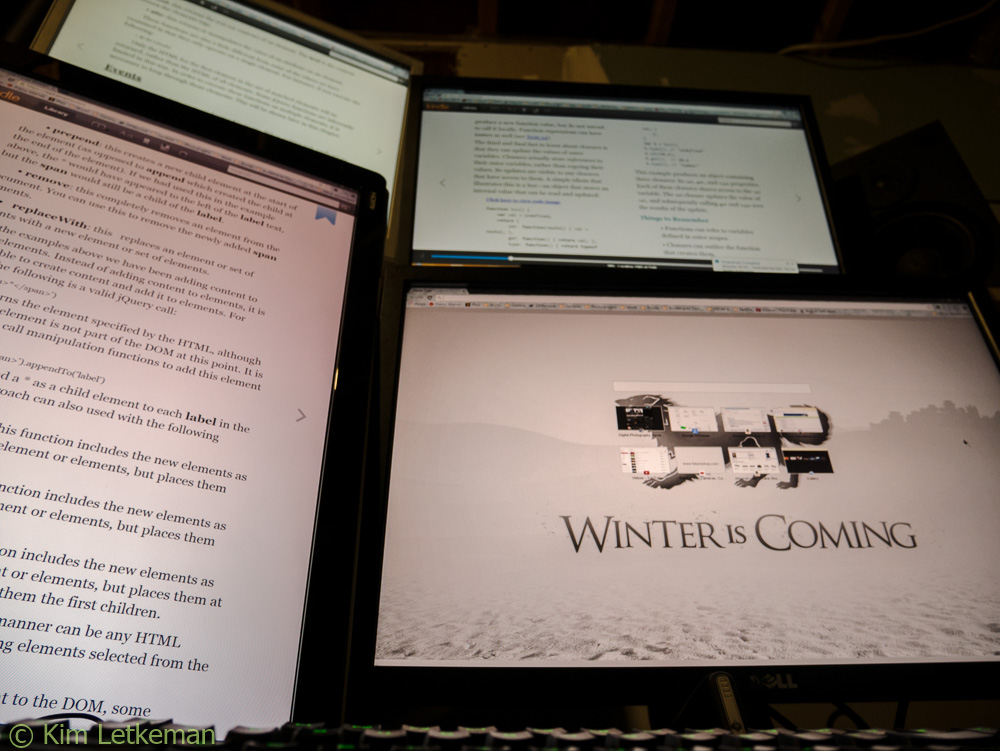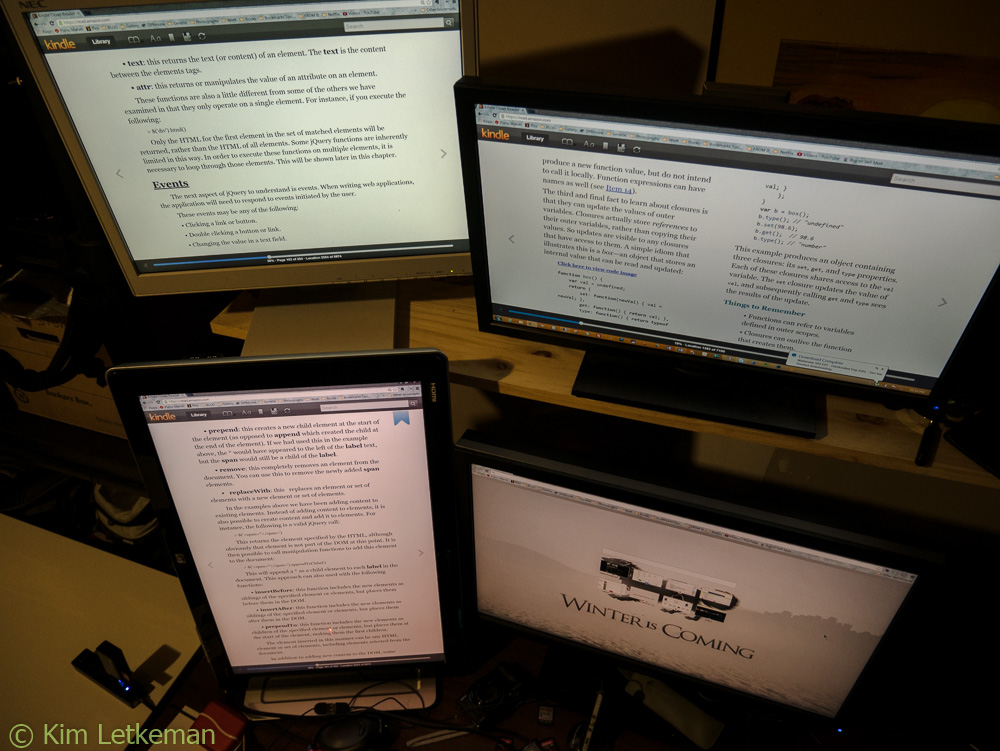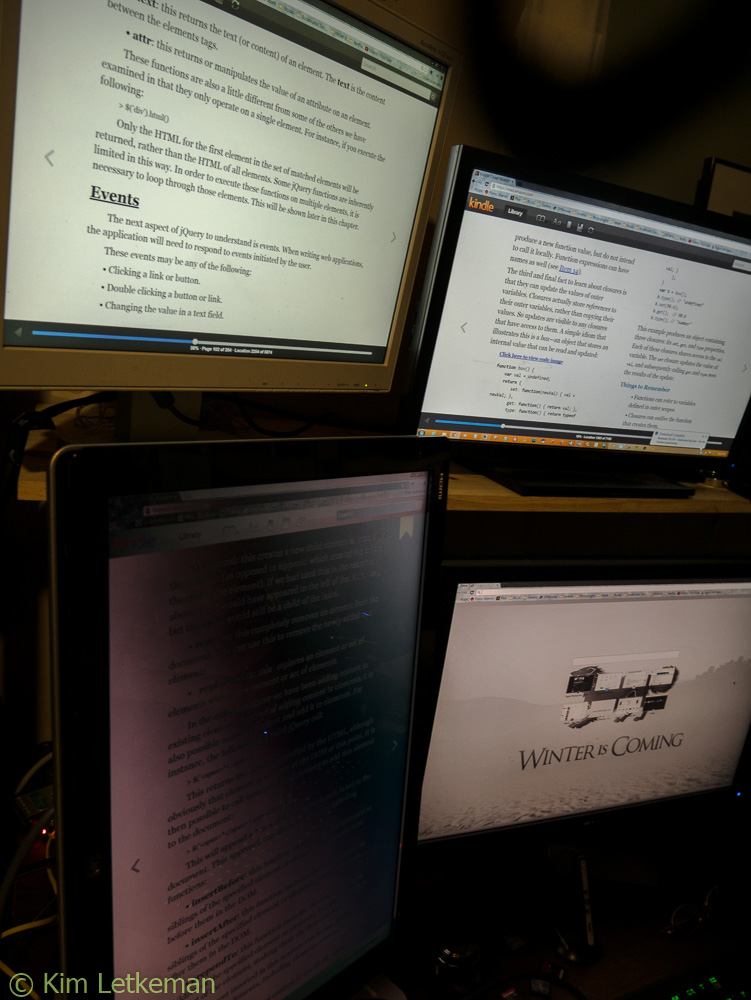So … I have been upgrading the man cave to allow me to work on many things at once. My job requires a great deal of reading, some programming, and a lot of talking. And I like to keep separate concerns on separate monitors. One of those concerns is my work laptop, which is connected into the VPN at work and is online at all times (except when I am travelling and it is in a bag.) Since I only want one keyboard and mouse, I log into the laptop via Remote Desktop and leave it in full screen mode on its own monitor.
Of course, when I had only one monitor, that was a major drag. Constantly flipping windows to change contexts drove me nuts. So of course I acquired a second monitor. And more recently, there have been more separate concerns and I acquired another monitor. That necessitated a second video card. And so on …

The top left screen is my very first LCD panel. It is a 20” 1600x1200 NEC AccuSync 200VX, which sports an MVA panel – one of the first LCD technologies to be able to offer 178 degrees angle of view in both horizontal and vertical directions. It remains an excellent panel.
Top right is my second monitor, a 23” 1080p DELL U2311H I think. This one uses an eIPS panel, which is the less expensive variety of IPS. IPS is the technology you want if you process images etc, as it offers excellent color fidelity. It also offers excellent angle of view, matching MVA.
The bottom right is also a DELL, the spectacular U2410, which has an H-IPS panel in it. A truly great panel and one of those 24” panels that has the original 16:10 aspect ratio instead of the becoming more common 1080p. This gives me much more room to work and I have to say that the panels look huge. This one was being sold on Kijiji by a young fellow at the University of Ottawa, and I got it for 220 bucks. Not super cheap, but for a large panel that can be calibrated to within a whisker of perfection, I don’t mind. The equivalent panel today is something like 400 to 500.
The bottom left is the lowly TN panel … something I thought I would never again buy. Well, I succumbed to the temptation because it is a gorgeous panel with very good angle of view horizontally and excellent sharpness and contrast, which comes from what HP calls “Brightview Technology” … marketing speak for “good.” And when reading Kindle books etc, it is nothing short of breathtaking. You can see how nice it looks in the image above. Bright and clear, just like the marketing team wanted you to believe. And I got it for 50 bucks, which makes the deal very sweet indeed.
However, it is far from perfect, as you will see in a moment. As I sit here with Gallery up on the HP, all the light text on dark background in the 4 inches from the right side is invisible. TN panels are notorious for having very poor angles of view. The standard is loose, so they often report 170/170, which is nonsense. The honest ones report 170/160 or 160/160. But that is still nonsense. In fact, horizontally you can already notice color shifts at the edges, just from the few degrees they are off center with respect to your eye plane. Vertically, they are often abysmal and this HP is even worse than that.
So … this test is pretty simple. Shoot them from below, above and far left. There is no room to shoot from the right, but you will see that the side view is very telling regarding the differences in these technologies.
Shooting from about 45 degrees from below shows that there is nothing going on. You can still see them perfectly. In fact, if there is anything to complain about, it would be that the DELL 24” might have issues at angles. Top right is not looking so good.

From above, the two IPS panels are looking a tad darker. The MVA looks amazing, and the TN also looks amazing. It does have a slight advantage, as it is tilted slightly upwards, but it remains near perfect.

Note: The HP is in portrait mode, which means that these two shots were testing its horizontal angle of view, which is always better on TN panels than the vertical angle of view. So what about its vertical performance, which I have telegraphed is going to suck?
Well …

OMG!! Yes, it really does that. In fact, I have Gallery running on it right now, and all the text on the right side is invisible. The angle of view is the worst I have ever seen.
Luckily, for my purposes, this is not an issue. But wow …
So the takeaway is that there is a very good reason why anyone doing color work would want IPS panels. There really is no contest. MVA has morphed over the years to A-MVA, and it definitely good for watching movies and working at angles to the screen. But color accuracy remains the domain of IPS. Even the cheap(er) eIPS panels are very good once calibrated.
And a plug for Kijiji … these two monitors are huge and really help with my work … I am amazed. And for the price of one decent smaller monitor, well, the value equation is excellent. I also got a smaller Samsung monitor in the summer on Kijiji. For 20 bucks. It is attached now to the MAC Mini for PianoMarvel duty. Although you have to be careful with Kijij, it can be a source of some decent monitors.